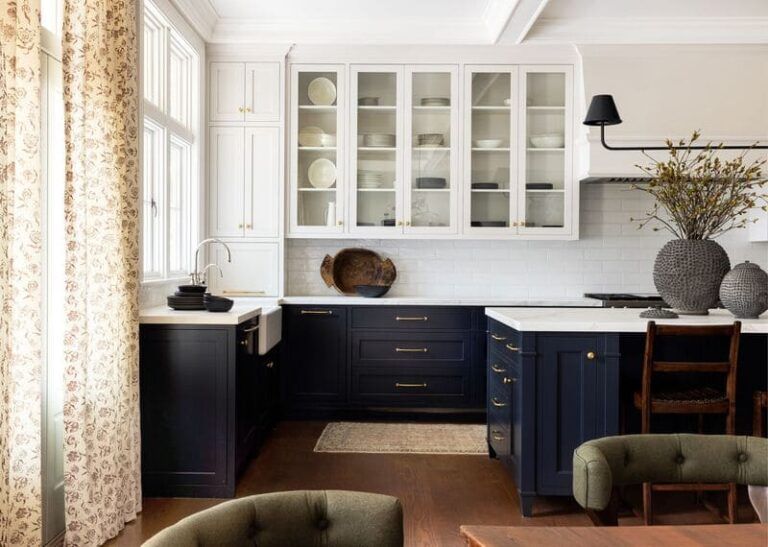Maintaining clean kitchen cabinets is essential for both the aesthetic appeal and hygiene of your kitchen. Cabinets not only store essential cooking utensils but also play a significant role in the overall design and functionality of your kitchen. Over time, they can accumulate dust, grease, and stains, making them look dull and uninviting. Fortunately, keeping your cabinets spotless doesn’t have to be a daunting task. With some simple tips and regular maintenance, you can ensure your kitchen cabinets remain clean and beautiful, enhancing the beauty of your culinary space.

When to Clean Your Kitchen Cabinets
To keep your clean kitchen cabinets looking their best, adopt a two-part cleaning approach: weekly spot treatments and seasonal deep cleans.
Weekly Cleaning:
- Use a multi-purpose cleaner in a spray bottle and a microfiber cloth to wipe away fingerprints, splatters, and other marks. Don’t forget to disinfect the hardware as well.
- This regular maintenance helps prevent grime buildup and keeps your cabinets looking fresh.
Seasonal Deep Cleaning:
- Perform a deep clean three to four times a year. Start by emptying the cabinets completely.
- Mix a gentle cleaner with warm water and use a microfiber cloth to wipe down both the inside and outside of the cabinets. Pay special attention to corners and crevices where grime tends to accumulate.
- Use a soft toothbrush to clean small areas that are hard to reach.
- Allow everything to dry completely before restocking your cabinets.
Regular clean kitchen cabinets not only enhances the appearance of your kitchen but also helps extend the life of your cabinets by preventing long-term damage.

How to Remove Stubborn Stains from Kitchen Cabinets
Fingerprints & Smudges
- Wipe with a microfiber cloth dampened with warm water.
- For tougher spots, mix white vinegar and water (1:1 ratio) in a spray bottle and apply directly to the affected areas.
- Buff with a clean cloth to restore shine.
Grease Buildup
- Cabinets above the stove are most prone to grease stains.
- Use a dish soap and warm water mixture to break down grease.
- If grease persists, mix baking soda with warm water to form a paste, apply it to the stain, let it sit for a few minutes, and wipe away with a damp cloth.
Food Stains & Splatters
- Wipe spills immediately with a damp cloth to prevent staining.
- For dried stains, mix soap and water, gently scrub with a soft sponge, and wipe dry.
- For stubborn stains, use a baking soda paste or white vinegar solution.
Water Stains & Hard Water Marks
- Hard water can leave streaks or white marks on cabinets.
- Use distilled water when cleaning to avoid mineral deposits.
- Wipe the surface with a clean, dry microfiber cloth after cleaning to remove excess moisture.
Scuff Marks & Scratches
- Use a melamine sponge (like a Magic Eraser) to gently buff out scuff marks on white cabinets.
- For wood cabinets, apply a small amount of olive oil or furniture polish to conceal minor scratches.

Cleaning Different Types of Kitchen Cabinets
Cleaning Stained Kitchen Cabinets
Choose to clean kitchen cabinets are prone to various stains due to their frequent use. Here’s how to tackle common stains:
- Fingerprints: Use a mixture of white vinegar and water (50-50 ratio) on a damp cloth to remove fingerprints. Buff the area with a polishing cloth for a smooth finish.
- Grease: Cabinets above the stove are particularly susceptible to grease stains. Use the same white vinegar solution as for fingerprints. You may need to repeat the process several times to fully remove the grease.
- Food Splatters: Clean up food spills immediately with a damp cloth to prevent stains from setting. For tougher stains, mix baking soda with water to form a paste, apply it to the stain, let it sit for a few minutes, and then wipe away. Polish the area with a clean cloth.
- Water Stains: If you have hard water, water stains can be a problem. Use distilled water when cleaning to prevent mineral deposits.
- Scuffs: For scuffs on white cabinets, use a gentle eraser to remove marks. Gently rub the eraser along the mark and wipe away the residue with a clean kitchen cabinets cloth.
Read more: Transform Your Home with Trendy Modern Kitchen Cabinets

Cleaning Different Types of Kitchen Cabinets
1. Cleaning Painted Kitchen Cabinets
Painted cabinets require gentle cleaning to avoid damaging the paint.
- Use soap and water or a white vinegar solution for everyday cleaning.
For stubborn grease stains, mix baking soda with warm water to create a paste, apply it to the stain, let it sit, then wipe clean kitchen cabinets.
If the paint begins to chip, touch it up with matching cabinet paint to maintain a fresh look.

2. Cleaning Wood Kitchen Cabinets
Wood cabinets require special care to maintain their finish.
- Avoid excessive water—use a damp cloth rather than a soaked one.
Clean with Murphy Oil Soap or a similar wood-safe cleaner to enhance shine.
Dry the cabinets with a microfiber cloth, always wiping in the direction of the wood grain.
Apply a wood polish or sealant periodically to protect the finish.
3. Cleaning Laminate Kitchen Cabinets
Laminate cabinets are easy to clean but can scratch easily.
- Use mild dish soap and warm water with a soft cloth for routine cleaning.
Avoid using abrasive sponges or scouring pads that can scratch the surface.
For stains, apply a paste made from baking soda and warm water, let it sit, and wipe clean.
For scuff marks on lower cabinets, use a soft eraser to remove them.

4. Cleaning Glass Kitchen Cabinets
Glass cabinets require extra care to prevent streaks and smudges.
- Use a glass cleaner or a mix of white vinegar and warm water to wipe down the panes.
Wipe with a lint-free polishing cloth to avoid streaks.
Don’t forget to clean both the inside and outside of the glass for a spotless finish.
Additional Tips for Maintaining Spotless Kitchen Cabinets
Keeping clean kitchen cabinets requires consistent maintenance. Follow these extra tips to prevent buildup and prolong the beauty of your cabinets:
Wipe Spills Immediately
- Prevent stains and discoloration by cleaning up spills as soon as they happen.
- Use a damp cloth and mild soap for everyday messes.
Use Cabinet Liners
- Place liners inside cabinets to protect against spills and stains.
This is especially useful in sink cabinets where water exposure is high.
Avoid Harsh Chemicals
- Stay away from bleach, ammonia, and strong detergents that can damage cabinet surfaces.
- Stick to mild dish soap, white vinegar, or baking soda-based cleaners.
Keep Cabinet Hardware Clean: Clean kitchen cabinets handles and knobs regularly using a microfiber cloth and soap and water to remove oils and dirt from frequent touching.
Deep Clean Seasonally: Set a reminder to deep clean kitchen cabinets every 3-4 months to keep them looking their best.
Final Thoughts on Keeping Kitchen Cabinets Clean
A well-maintained kitchen is not only more inviting but also more hygienic. By following a simple cleaning routine, using the right clean kitchen cabinets solutions, and regularly maintaining your cabinets, you can ensure that your kitchen always looks spotless and fresh.
Repainting clean kitchen cabinets might be an option if the surfaces become too worn, but with proper cleaning and care, you can extend the life of your cabinets significantly. Whether you have wood, painted, laminate, or glass cabinets, using mild dish soap, white vinegar, baking soda, and warm water will help keep them clean and beautiful for years to come.
Conclusion
In summary, achieving clean kitchen cabinets is a feasible goal that can significantly enhance the appearance and experience of your kitchen. By implementing these straightforward tips—such as regular cleaning routines, using appropriate cleaning products, and being mindful of how you store items—you can maintain a spotless look that reflects your commitment to cleanliness and organization. A well-maintained kitchen not only improves functionality but also creates an inviting environment for family and friends. Start today, and enjoy the benefits of a pristine kitchen that inspires culinary creativity!
Read more: The Use of Natural Materials in Home Decor








